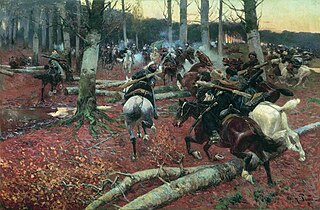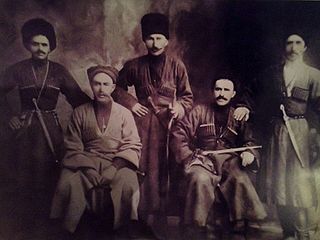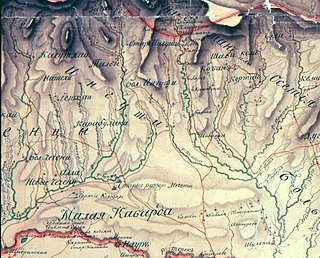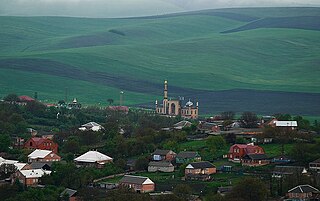Ingush, historically known as Durdzuks, Gligvi and Kists, are a Northeast Caucasian ethnic group mainly inhabiting the Republic of Ingushetia in central Caucasus, but also inhabitanting Prigorodny District and town of Vladikavkaz of modern day North-Ossetia. The Ingush are predominantly Sunni Muslims and speak the Ingush language.

The Caucasian War or the Caucasus War was a 19th-century military conflict between the Russian Empire and various peoples of the North Caucasus who resisted subjugation during the Russian conquest of the Caucasus. It consisted of a series of military actions waged by the Russian Imperial Army and Cossack settlers against the native inhabitants such as the Adyghe, Abaza-Abkhazians, Ubykhs, Chechens, and Dagestanis as the Tsars sought to expand.

The Orstkhoy, historically commonly known under their exonyms: Karabulaks, Balsu, Baloy, are a historical ethnoterritorial society among the Chechen and Ingush peoples. Their homeland is in the upper reaches of the Assa and Fortanga rivers in the historical region of Orstkhoy-Mokhk. In the tradition of the Chechen ethno-hierarchy, it is considered one of the nine historical Chechen tukkhums, in the Ingush tradition as one of the seven historical Ingush shahars.
Galashki is a rural locality in Sunzhensky District of the Republic of Ingushetia, Russia, located on the left bank of the Sunzha River near the border with the Republic of North Ossetia–Alania. Its population was about 9,000 people in 2009. Galashki forms the municipality of the rural settlement of Galashki as the only settlement in its composition.
Bamut is a non-residential rural locality in Sernovodsky District of the Republic of Chechnya, Russia. From 1922 to 1934, Bamut was a part of the Ingush Autonomous Oblast.

The Act of oath of six Ingush clans to Russia was a treaty between ten representatives of six major Ingush clans (teips) and the Russian Empire. It was signed on August 22, 1810 in the city of Vladikavkaz. Due to this oath, the Ingush were given the right to settle the land along the right bank of the Terek up to the ridge.

GalashkinskoeNaibstvo, self-designated as Vilayet Kalay, was an Ingush administrative unit of the Caucasian Imamate. The Naibstvo was the farthest region of the Imamate in the west and it was established on the territory of Galashian society.

Orstkhoy-Mokhk historically known by exonyms: Balsu, Karabulak is a historical region on the territories of Ingushetia and Chechnya. Orstkhoy-Mokhk is the territory of historical settlement of Orstkhoy, a sub-ethnic group of the Ingush and Chechens.

Galashians, were a historical Ingush ethnoterritorial society, which formed in the middle of the 18th century. The name comes from the village of Galashki, which is geographically located in the very center of the society. Galashians were located in the middle and lower reaches of the river Assa and the basin of the river Fortanga.
Ingush societies or shahars were ethnoterritorial associations of the Ingush based on the geographical association of several villages and intended for conditional administrative-territorial delimitation of the Ingush ethnic group. The formation and functioning of most of them dates back to the late Middle Ages. During this period, their boundaries, number and names changed.

The Nazranians were a historical Ingush ethnoterritorial subethnic group (society) which inhabited modern day Nazranovsky District and Prigorodny District.

Khamkhins, also known as Ghalghaï, were a historical Ingush ethnoterritorial society, which was located in the upper reaches of the Assa River. The Khamkhin society, like the Tsorin society, was formed from the former "Ghalghaï society" as a result of the transfer of rural government to Khamkhi.

Tsorins, Tsori, also Ghalghaï, were a historical Ingush ethnoterritorial society that was located in mountainous Ingushetia in the region of river Guloykhi. The center of the society was Tsori from which it got its name. Tsorin society, like the Khamkhin society, was formed from the former "Galgaï society" as a result of the transfer (appearance) of rural government to the village Tsori.
Arshty is a rural locality in Sunzhensky District of the Republic of Ingushetia, Russia, located on left bank of the river Arshtynka near the border with the Republic of Chechnya. It forms the municipality of the rural settlement of Arshty as the only settlement in its composition.

Ekazhevo is a rural locality in Nazranovsky District of the Republic of Ingushetia, Russia. It forms the municipality of the rural settlement of Ekazhevo as the only settlement in its composition.

Barsuki is a rural locality in Nazranovsky District of the Republic of Ingushetia, Russia. It forms the municipality of the rural settlement of Barsuki as the only settlement in its composition.

Surkhakhi is a rural locality in Nazranovsky District of the Republic of Ingushetia, Russia. It forms the municipality of the rural settlement of Surkhakhi as the only settlement in its composition.
Dattykh is a rural locality in Sunzhensky District of the Republic of Ingushetia, Russia, located on the left bank of the river Fortanga. It forms the municipality of the rural settlement of Dattykh as the only settlement in its composition.

Ingush okrug was a district (okrug) of the Terek Oblast of the Caucasus Viceroyalty of the Russian Empire. The area of the Ingushskiy okrug made up part of the North Caucasian Federal District of Russia.
Gandalbos is rural locality in Sunzhensky District of the Republic of Ingushetia, Russia, located on the left bank of the river Fortanga. It is part of the municipality of the rural settlement of Dattykh.













